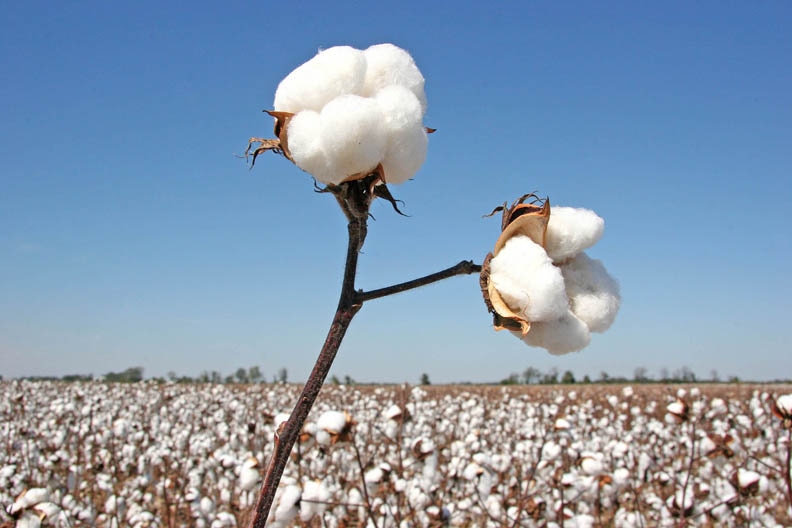
Although cotton futures prices remain in a tight trading range between 59 cents and 60 cents, there could be a sliver of optimism with a combination of world production falling in 2015-16 and consumption rising, according to O.A. Cleveland, Extension professor emeritus, Mississippi State University.
Speaking at the Ag Market Network’s January conference call, Cleveland says numbers from USDA’s January World Agricultural Supply and Demand Estimates were expected by the trade for the most part. There was not much change in domestic use or exports for cotton, although the agency increased U.S. ending stocks by 100,000 bales to 4.7 million bales.
USDA’s estimate of world ending was marginally increased, to 108 million bales. “That’s a couple of million bales down from the high water mark of a couple of months ago, but some in the industry believe the figure is seven million to eight million bales lower than that. But at this point, 100 million bales is still a large number,” Cleveland said.
Consumption in China was lowered again, which was a surprise to Cleveland. “Everything I’m picking up says consumption is increasing in China. I think as the year progresses, that we will see world consumption increase.”
One factor favoring the possibility of higher cotton consumption are lower gasoline prices, which Cleveland says will create higher disposable incomes, with at least some of that being spent on apparel, preferably cotton.
Another factor for China continuing to explore the export market is its need for high quality cotton, according to Cleveland. “The Xinjiang Province crop in China is not as large as anticipated. Sooner or later, China will have to come back into the market for high quality cottons.”
With export supplies from Australia and Brazil generally committed elsewhere, “that means China will have to come to the United States for high quality cotton, which will take our exports up 200,000 bales or more,” Cleveland said.
Cleveland believes in the short-term, the market will continue to trade in a narrow range between 59 cents and 60 cents. “We certainly need to stay above the 58-cent barrier, which is the low point. But it seems like anytime we get down to around 59 cents, we’ve uncovered so much demand that we took the market back. I would expect this to continue to be the case.”
One key to the export market is India, according to Jarral Neeper, president of Calcot. “USDA has lowered world consumption, with China down a million bales and India down a half million bales since November. If the numbers on India are accurate, clearly that’s going to put more pressure on the export market. Indian stocks are starting to get quite large, at 14 million bales plus. At least in China, those large stocks are primarily in government hands. I don’t see how India can continue to sit on such a large stockpile without getting more aggressive.”
U.S. cotton acres are also expected to decline with current prices below the cost of production for many growers, Cleveland noted. Only producers who are able to offset lower prices with higher yield are likely to be somewhat comfortable with prices in the 60s.
The problem for Mid-South cotton producers is the rising cost of controlling plant bugs, Cleveland said. “It adds $100 per acre to $200 per acre to production and knocks them out of the game. That’s why acreage has gone down.”
On the positive side worldwide, Cleveland believes that China will reduce cotton acres by 15 percent to 18 percent in 2015-16.
“The world needs to reduce acres by 7 percent to 10 percent in 2015-16,” Neeper added. “I think we’ll get that in the United States. In the world, I’m looking for 110 million or fewer bales produced this year. We can’t continue to produce 118 million bales and consume 112 million to 113 million bales.”
Neeper also sees a tight trading range continuing with a possibility for higher prices later. “It’s been difficult for the market to make new lows, so the longer we continue to build our base, the better the case for higher prices down the road. If the job of the market is to reduce plantings, I don’t see December moving a lot higher until we get past plantings and we see what is happening in various countries around the world. By late summer, early fall, we could get up to 70 cents to 72 cents. Staying there could be a lot tougher. We’re still going to have to work hard to get past 67 cents.”
“If we are successful in dropping world production down to 106 million bales and can maintain consumption at 118 million bales or greater, then we’re taking 10 million bales off the table,” Cleveland said. “China is going to have to come back to the export market. And if we have weather like we did last year, then all of a sudden, we don’t have a supply problem.”
About the Author(s)
You May Also Like






